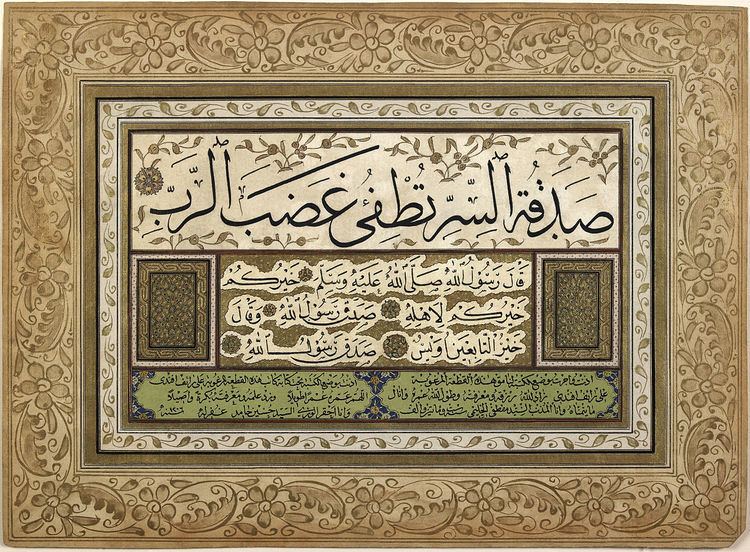 | ||
An ijazah (Arabic: الإِجازَة ) is the grant of permission or authority usually represented by a certificate used primarily by Sunni Muslims to indicate that one has been authorized by a higher authority to transmit a certain subject or text of Islamic knowledge. This usually implies that the student has learned this knowledge through face-to-face interactions "at the feet" of the teacher. The ijazah was limited to the study of Islamic law (sharia) and in the transmission of knowledge (gnosis) in the Islamic spiritual tradition Sufism. Philosophy, natural sciences and Islamic theology (kalam) were excluded.
Contents
Description
In a paper titled Traditionalism in Islam: An Essay in Interpretation, Harvard professor William A. Graham explains the ijazah system as follows:
The basic system of "the journey in search of knowledge" that developed early in Hadith scholarship, involved travelling to specific authorities (shaykhs), especially the oldest and most renowned of the day, to hear from their own mouths their hadiths and to obtain their authorization or "permission" (ijazah) to transmit those in their names. This ijazah system of personal rather than institutional certification has served not only for Hadith, but also for transmission of texts of any kind, from history, law, or philology to literature, mysticism, or theology. The isnad of a long manuscript as well as that of a short hadith ideally should reflect the oral, face-to-face, teacher-to-student transmission of the text by the teacher's ijazah, which validates the written text. In a formal, written ijazah, the teacher granting the certificate typically includes an isnad containing his or her scholarly lineage of teachers back to the Prophet through Companions, a later venerable shaykh, or the author of a specific book.
Hypothesis on origins of doctorate
The generally accepted view, as expounded by Lexikon des Mittelalters and A History of the University in Europe, is that the origin of the doctorate lies in European high medieval teaching with its roots going back to late antiquity and the early days of Christian teaching of the Bible. This view is indirectly supported by the entry on the "Madrasa" in the Encyclopedia of Islam which draws no parallels between Islamic and Christian medieval learning and does not refer to any transmission process either way.
This view is further echoed by George Makdisi in a 1970 investigation into the differences between the Christian university and the Islamic madrasah, where he is of the opinion that the Christian doctorate of the medieval university was the one element in the university that was the most different from the Islamic ijazah certification.
According to a 1989 hypothesis by George Makdisi, the origins of the Christian medieval doctorate ("licentia docendi") dates back to the ijāzah al-tadrīs wa al-iftā' ("license to teach and issue legal opinions") in the medieval Islamic legal education system. Makdisi proposed that the ijazat attadris was the origin of the European doctorate, and went further in suggesting an influence upon the magisterium of the Christian Church. According to the 1989 paper, the ijazat was equivalent to the Doctor of Laws qualification and was developed during the 9th century after the formation of the Madh'hab legal schools. To obtain a doctorate, a student "had to study in a guild school of law, usually four years for the basic undergraduate course" and at least ten years for a post-graduate course. The "doctorate was obtained after an oral examination to determine the originality of the candidate's theses," and to test the student's "ability to defend them against all objections, in disputations set up for the purpose" which were scholarly exercises practiced throughout the student's "career as a graduate student of law." After students completed their post-graduate education, they were awarded doctorates giving them the status of faqih (meaning "master of law"), mufti (meaning "professor of legal opinions") and mudarris (meaning "teacher"), which were later translated into Latin as magister, professor and doctor respectively. However, Norman Daniel criticizes Makdisi for relying exclusively on superficial similarities between the two education systems, while failing to cite any historical evidence for an actual transmission.
The commonly held view is that all these titles were proper developments of the medieval university in Europe and completely unrelated to the Islamic mosque schools.
It should be noted that madrasas only issued the ijazat attadris in one field, the Islamic religious law of Sharia, and in no other field of learning. Other academic subjects, including the natural sciences, philosophy and literary studies, were only treated "ancillary" to the study of the Sharia. The Islamic law degree in Al-Azhar University, the most prestigious madrasa, was traditionally granted without final examinations, but on the basis of the students' attentive attendance to courses. However, the postgraduate doctorate in law was only obtained after "an oral examination." In a 1999 paper, Makdisi points out that, in much the same way granting the ijazah degree was in the hands of professors, the same was true for the early period of the University of Bologna, where degrees were originally granted by professors. He also points out that, much like the ijazat attadris was confined to law, the first degrees at Bologna were also originally confined to law, before later extending to other subjects. In a discussion of Makdisi's thesis, Toby Huff disagreed and argued that there was never any equivalent to the Bachelor's degree or the doctorate in the Islamic madrasahs.
